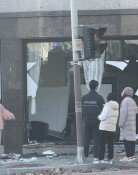South Korean military readiness severely lacking
South Korean military readiness severely lacking
Posted December. 28, 2022 07:43,
Updated December. 28, 2022 07:43
One of the five unmanned aircraft from North Korea that crossed the inter-Korean border on Monday may have photographed the Presidential Office in Yongsan. It had not only penetrated the air force defense network and illegally trespassed the skies of Seoul, but also approached the heart of Seoul and attempted to collect data. South Korean armed forces, however, failed to shoot down the drones visible to the naked eye and even misinterpreted a flock of birds as drones.
The fact that North Korean drones penetrating our defense network and illegally spying on our facilities itself is threatening. What is more intimidating is that the data collected could be used in terrorist attacks or provocative attacks. If the drone had high-performance explosives or chemical and biological weapons attached, it may have brought about major calamities in Seoul. North Korea is estimated to run up to 1,000 drones. We do not know how these can be leveraged in what type of threat or terrorist attacks.
North Korea’s blatant acts of violating the September 19 military agreement and sending five drones is an intentionally designed provocation to create confusion, raise tension on the Korean Peninsula and test our response. North Korea has fired around 60 ballistic missiles around 30 times this year but has failed to get anything in return. Its anxiety levels are higher than ever, and it will attempt to increase the level of provocation even higher, starting with Kim Jong Un’s New Year’s message next year. Kim has warned that it will “establish more reinforced and certain battling strategies.”
South Korea’s defense response is crushing. Air forces mobilized 20 combat aircraft, including Apache, Cobra, and other attack helicopters, and fired 100 times but failed to bring the drones down. The KA-1 light attack aircraft even crashed down. The air force misidentified a flock of birds near Seokmodo, Incheon, as drones and sent out emergency warning texts to residents nearby. Only 10 days before Chair Kim Seong-kyeom of the Joint Chiefs of Staff had instructed to increase preparations against rising drone activity identified in the East and West regions. What is the excuse for the failure even if it had been aware of North Korea’s actions?
It was 2014 when a North Korean drone spying on the Blue House was identified. We cannot help but wonder what the armed forces have done to prepare against North Korea since then. We urgently need more advanced and sophisticated equipment in place by further developing the Korean Jammer, which is still in its development infancy. Armed forces should review our weak points such as lacking the ability to detect and strike small drones and striking assets to fill gaps in our defense system. We should also reinforce Korea-US Combined Defense System to better respond to ICBM missile activities and local provocation.




![[김순덕의 도발] ‘李부터 연임’ 개헌, 이 대통령은 가능성을 말했다](https://dimg.donga.com/c/138/175/90/1/wps/NEWS/IMAGE/2026/01/16/133172656.1.jpg)


